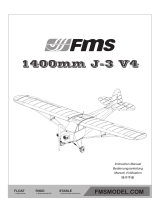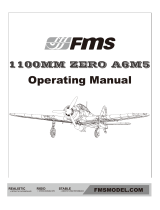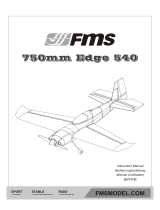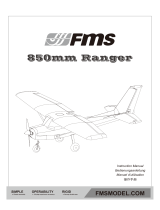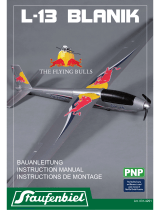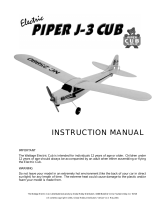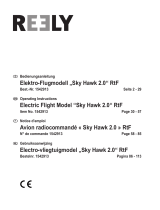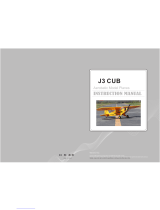Page is loading ...

FLOAT
Optional float
RIGID
Strong durable EPO
STABLE
Smooth flying performance
1700mm PA-18
Super Cub

WARNING: Read the ENTIRE instruction manual to become familiar with the features of the product before operating.
Failure to operate the product correctly can result in damage to the product,personal property and cause serious injury.
This is a sophisticated hobby product and NOT a toy. It must be operated with caution and common sense and failure to do so
could result in injury or damage to the product or other property. This product is not intended for use by children without direct
adult supervision.
This manual contains instructions for safety operation and maintenance. It is essential to read and follow all the instructions and
warnings in the manual prior to assembly, setup or use, in order to operate and avoid damage or serious injury.
WARNING
As the user of this product, you are solely responsible for operating in a manner that does not endanger yourself and others or
result in damage to the product or the property of others. This model is controlled by a radio signal subject to interference from
many sources outside your control. This interference can cause momentary loss of control so it is advisable to always keep a
safe distance in all directions around your model, as this margin will help avoid collisions or injury.
Age Recommendation: Not for children under 14 years. This is not a toy.
·Never operate your model with low transmitter batteries.
·Always operate your model in an open area away from cars, traffic or people.
·Avoid operating your model in the street where injury or damage can occur.
·Never operate the model in populated areas for any reason.
·Carefully follow the directions and warnings for this and any optional support equipment you use (chargers,rechargeable
battery packs, etc.)
·Keep all chemicals, small parts and anything electrical out of the reach of children.
·Moisture causes damage to electronics. Avoid water exposure to all equipment not specifically designed and protected for this
purpose.
·Never lick or any place of any your model in your mouth as it could cause serious injury or even death.
Lithium Polymer (Li-Po) Battery Warning
CAUTION: Always follow the manufacturer’s instructions for safe use and disposal of batteries. Fire, property
damage, or serious injury can result from the mishandling of Li-Po batteries.
By handling, charging or using a Li-Po Battery you assume all risks associated with lithium batteries.
If at any time the batteries begin to swell or balloon, discontinue use immediately!
Always store the batteries at room temperature in a dry area to extend the life of the battery. Always transport
or temporarily store the battery in a temperature range of 40-120F. Do not store the battery or model in a car or in direct sunlight.
If stored in a hot car, the battery can be damaged or even catch fire.
Never use a Ni-Mh Charger to charge Li-Po Batteries. Failure to charge the battery with a Li-Po compatible charger
may cause fire resulting in personal injury and property damage.
Never discharge Li-Po Cells below 3V.
Never leave charging batteries unattended.
Never charge damaged batteries.
Charging the Flight Battery Warning
Use a battery charger that is designed to safely charge the Li-Po Battery. Read the charger instructions care
fully before use. When charging the battery, make certain the battery is on a heat resistant surface. It is also highly
recommended to place the Li-Po Battery inside a fire resistant charging bag readily available at hobby shops or
online.
p w

3
Before assembly, please inspect the contents of the kit. The
photo below details the contents of the kit with labels. If any
parts are missing or defective, please identify the name or
part number (refer to the spare parts list near the end of the
manual) then contact your local shop or email us: support
Kit contents
A: Fuselage
B: Main wing
C: Horizontal stabilizer
D: Landing gear H: Wing/ Horizontal Stabilizer spar
I:Floats and accessories
E: Propeller
F: Screws and pushrods
G: Antenna
Introduction
Kit contents
Model assembly
Battery installation
Receiver diagram
Preflight check
Clevis installation
Control horn and servo arm settings
Center of gravity(CG)
Before flying the model
Flying course
Troubleshooting
Spare parts list content
Table of contents
·····························································
·····
3
·························································3
·······················································4
············································· ········ 7
·········································
··
········ 8
··································
·····
·····
·····
·····
8
····················································10
··························
·················
10
··············································· 10
··············································11
···························································11
······················································12
············································12
Introduction
The Piper PA-18 Super Cub is a two-seat, single-engine
monoplane. It was developed from the Piper PA-11. In close to
40 years of production, over 9,000 were built. Super Cubs are
commonly found in roles such as bush flying, banner towing and
glider towing.
As a relative of the popular 1400mm J-3 Cub, the 1700mm
PA-18 Super Cub retains great flight characteristics while
offering increased power and wingspan.
Thanks to its functional flaps, high-lift airfoil, rugged landing
gear and oversized balloon tires- the 1700mm PA-18 Super Cub
has impressive short take-off and landing (STOL) performance,
allowing it to operate from just about any terrain.
Utilizing the latest FMS hardware and design, the 1700mm
PA-18 Super Cub has pre-installed ball-link type pushrods,
integrated servo connectors in the wing structure and can be
assembled very easily using no glue at all.
For pilots wanting to get the genuine bush-plane experience, the
PA-18 Super Cub can be equipped with floats.
Versatile, fun and exceptionally relaxing to fly- the 1700mm
PA-18 Super Cub is a great addition to any fleet!
Wingspan: 1700mm(66.9in)
Overall length: 1136mm(44.7in)
Flying weight: ~ 2100g
Motor size: 3541-KV750
Wing load: 50g/dm²(0.11oz/in²)
Wing area: 42dm²(651sq.in)
ESC: 45A
Servo: 17g Servo x 6
Recommended battery: 14.8V 2200-2600mAh 35C
Specifications
@fmsmodel.com
Features:
• Powerful 3541- KV750 Outrunner motor with Predator 45A
ESC provides adequate thrust for any situation
• CNC metal landing gear structure for less-than-perfect landings
• 6.25-inch oversized balloon tires for all-terrain operations
• STOL capable (Takes off in less than 3m/10ft)
• Pre-installed navigation and landing lights
• Two-piece wing and horizontal stabilizer for easy transportation
• Integrated servo connectors
• Screw-together assembly
• Large battery bay
• Ball-linked pushrods for increased precision
• Tough two bladed Nylon propellers
• Functional flaps
• Optional floats and stainless-steel wing struts
A.
B.
C.
F.
G.
H.
D.
E.
I.

Landing gear assembly
Wing installation
4
Model assembly
1.With the fuselage inverted and hook inserted as shown, install the landing gear assembly onto the fuselage using the included
screws and plastic retainers.
2.Attach the springs to the landing gear assembly as shown
2. Use the wing bolts to secure the wing halves as shown.
1. Insert the wing spar into the pass-through on the fuselage.
Insert both wing halves onto the wing spar.
Note: Ensure that the wing halves and plugs are properly seated
onto the fuselage.
HKM3.0*10
HKM3.0*16

Horizontal stabilizer installation
3. Using the included screws, insert and secure the wing struts
as shown.
1. Insert the horizontal stabilizer spar into the pass-through on the
fuselage. Insert both halves of the horizontal stabilizer.
2. Use the included bolts to secure the horizontal stabilizer.
5
Model assembly
HKM3.0*10
HKM3.0*10

6
1. With the elevator servo centered, connect the pushrod to the
control horn on the elevator.
Note:Refer to the control horn and servo horn installation
instructions
on page 10 for more information.
1. Apply foam-safe glue on the bottom of the antenna, then
gently push the component into its wing slot.
1. Install the propeller in the order as shown.
Model assembly
Antenna installation
Propeller installation
Installation of the elevator pushrods
HKM3.0*10
a
b
c
d
e
Foam-safe glue

1. Install the struts onto the floats as shown- using the hardware
provided with the float set. Secure the float assembly using
screws.
2. Using the screws and plastic retainers shown, secure the
float assembly to the fuselage.
1. Remove the battery hatch.
2. Remove the hook and loop tape from the fuselage. Apply the
looped surface to the battery.
3. Install the battery into the fuselage- securing it with the
preinstalled battery straps.
Note: The weight of each battery may vary due to different
manufacturing techniques. Move the battery fore or aft to
achieve the optimal center of gravity.
Model assembly
7
Battery installation
Float installation
Screws 3*4
HKM3.0*10

Important ESC and model information
The ESC included with the model has a safe start. If the motor battery is connected to the ESC and the throttle stick is not in
the low throttle or off position, the motor will not start until the throttle stick is moved to the low throttle or off position. Once the
throttle stick is moved to the low throttle or off position, the motor will emit a series of beeps. Several beeps with the same tune
means the ESC has detected the cells of the battery. The count of the beeps equals the cells of the battery. The motor is now
armed and will start when the throttle is moved.
The motor and ESC come pre-connected and the motor rotation should be correct. If for any reason the motor is rotating in the
wrong direction, simply reverse two of the three motor wires to change the direction of rotation.
The motor has an optional brake setting. The ESC comes with brake switched off and we recommend that the model be flown
with the brake off. However, the brake could be accidentally switched on if the motor battery is connected to the ESC while the
throttle stick is set at full throttle. To switch the brake off, move the throttle stick to full throttle and plug in the motor battery. The
motor will beep one time. Move the throttle stick to low throttle or the off position. The motor is ready to run and the brake will
be switched off.
Battery Selection and Installation. We recommend the 14.8V 2200-2600mAh 35C Li-Po battery. If using another battery, the
battery must be at least a 14.8V 2200-2600mAh 35C battery. Your battery should be approximately the same capacity, dimen-
sion and weight as the 14.8V 2200-2600mAh 35C Li-Po battery to fit the fuselage without changing the center of gravity signifi-
cantly.
1.
2.
3.
4.
8
Receiver diagram
Preflight check
The cables from the servo connector board should be connected
to your receiver in the order shown. Note that the LEDs can be
powered by any spare channel on the receiver. Tuck the wire
leads into the recessed cavity towards the rear of the battery
hatch.
6
Flap
Flap
6

Transmitter and model setup
Before getting started, bind your receiver with your transmitter.
Please refer to your transmitter manual for proper operation.
CAUTION: To prevent personal injury, DO NOT install the propel-
ler assembly onto the motor shaft while testing the control surfac-
es. DO NOT arm the ESC and do not turn on the transmitter until
the Transmitter Manual instructs you to do so.
Tips: Make sure all control sticks on your radio are in the neutral
position (rudder, elevator, ailerons) and the throttle is in the OFF
position. Make sure both ailerons move up and down (travel) the
same amount. This model tracks well when the left and right
ailerons travel the same amount in response to the control stick.
Move the controls on the transmitter to make sure the aircraft
control surface moves correctly. See diagrams right.
9
Control throws
The suggested control throw setting for the PA-18 super cub are as follows (dual rate setting):
Tips: On the first flight, fly the model in low rate.
The first time you use high rates,be sure to fly at
low to medium speeds. High rate, as listed, is only
for EXTREME maneuvering.
Aileron
Bank left
Bank right
Elevator
Climb
Descend
Steering Rudder
Steer left
Steer right
18 14
12
20
16
28

10
More control throw
Less control throw
Horns Arms
a.
b.
c.
d.
e.
f.
Clevis installation
1.Pull the tube from the clevis to the linkage.
2.Carefully spread the clevis, then insert the clevis pin into the
desired hole in the control horn.
3.Move the tube to hold the clevis on the control horn.
Control horn and servo arm settings
The table shows the factory settings for the control horns
and servo arms. Fly the aircraft at the factory settings
before making changes.
After flying,you may choose to adjust the linkage positions
for the desired control response.
ElevatorRudderAilerons
Check the C.G. (Center of gravity)
When balancing your model, adjust the battery as necessary
so the model is level or slightly nose down. This is the correct
balance point for your model. After the first flights, the CG
position can be adjusted for your personal preference.
1. The recommended Center of Gravity (CG) location for your
model is(80-85mm) from the leading edge of the main wing
(as shown) with the battery pack installed. Mark the location of
the CG on top of the wing.
2. When balancing your model, support the plane at the marks
made on the bottom of the main wing with your fingers or a
c
ommercially available balancing stand. This is the correct
balance point for your model. Make surethe model is assembled
and ready for flight before balancing.
80mm-85mm

Take off
Maintenance
Landing
Find a suitable flying site
Perform the range check for your plane
Monitor your flight time
Find a flying site clear of buildings, trees, power lines and
other obstructions. Until you know how much area will be
required and have mastered flying your plane in confined
spaces, choose a site which is at least the size of two to three
football fields - a flying field specifically for R/C planes is best.
Never fly near people - especially children, who can wander
unpredictably.
As a precaution, an operational ground range test should be
performed before the first flight each time you go out.
Performing a range test is a good way to detect problems
that could cause loss of control such as low batteries, defective
or damaged radio components, or radio interference. This
usually requires an assistant and should be done at the actual
flying site you will be using.
First turn on the transmitter, then install a fully-charged battery
into the fuselage. Connect the battery and install the hatch.
Remember, use care not to bump the throttle stick. Otherwise,
the propeller/fan will turn and possibly cause damage or injury.
Note: Please refer to your Transmitter Manual that came with
your radio control system to perform a ground range check. If
the controls are not working correctly or if anything seems
wrong, do not fly the model until you correct the problem. Make
certain all the servo wires are securely connected to the
receiver and the transmitter batteries have a good connection.
Monitor and limit your flight time using a timer (such as on a
wristwatch or in your transmitter if available). When the
batteries are getting low you will usually notice a performance
drop before the ESC cuts off motor power, so when the plane
starts flying slower you should land. Often (but not always)
power can be briefly restored after the motor cuts off by
holding the throttle stick all the way down for a few seconds.
To avoid an unexpected dead-stick landing on your first flight,
set your timer to a conservative 4 minutes. When your alarm
sounds you should land right away.
11
Before flying the model
Flying course
While applying power, slowly steer to keep the model straight.
The model should accelerate quickly. As the model gains flight
speed you will want to climb at a steady and even rate. It will
climb out at a nice angle of attack (AOA).
Flying
Always choose a wide-open space for flying your plane. It is
ideal for you to fly at a sanctioned flying field. If you are not
flying at an approved site always avoid flying near houses,
trees, wires and buildings. You should also be careful to avoid
flying in areas where there are many people, such as busy
parks, schoolyards, or soccer fields. Consult laws and
ordinances before choosing a location to fly your aircraft. After
takeoff, gain some altitude. Climb to a safe height before trying
technical manoeuvres, including high speed passes, inverted
flight, loops, and point rolls.
Land the model when you hear the motor pulsing (LVC) or if
you notice a reduction in power. If using a transmitter with a
timer, set the timer so you have enough flight time to make
several landing approaches.
The model’s three point landing gear allows the model to land
on hard surfaces. Align model directly into the wind and fly
down to the ground. Fly the airplane down to the ground using
1/4-1/3 throttle to keep enough energy for proper flare. Before
the model touches down, always fully decrease the throttle to
avoid damaging the propeller or other components. The key to
a great landing is to manage the power and elevator all the
way to the ground and set down lightly on the main landing
gear. After a few flights you will find the model can be set down
lightlyon the mains and you can hold the nose wheel off
balancing themodel on the mains until it slows and gently
settles the nose.
Repairs to the foam should be made with foam safe adhesives
such as hot glue, foam safe CA, and 5min epoxy. When parts
are not repairable, see the Spare Parts List for ordering by item
number.
Always check to make sure all screws on the aircraft are
tightened. Pay special attention to make sure the spinner is
firmly in place before every flight.

12
Trouble shooting
Problem Possible Cause Solution
Aircraft will not respond to
the throttlebut responds to
other controls.
-ESC is not armed.
-Throttle channel is reversed.
-Lower throttle stick and throttle trim to lowest settings.
-Reverse throttle channel on transmitter.
Extra propeller noise or
extra vibration.
-Damaged spinner, propeller,
motor or motor mount.
-Loose propeller and spinner parts.
-Propellor installed backwards.
-Replace damaged parts.
-Tighten parts for propeller adapter, propeller and spinner.
-Remove and install propeller correctly.
Reduced flight time or
aircraft underpowered.
-Flight battery charge is low.
-propeller installed backward.
-Flight battery damaged.
-Completely recharge flight battery.
-Replace flight battery and follow flight battery
instructions.
Control surface does not
move, or is slow to respond
to control inputs.
-Control surface, control horn,
linkage or servo damage.
-Wire damaged or connections
loose.
-Replace or repair damaged parts and adjust controls.
-Do a check of connections for loose wiring.
Controls reversed.
Channels are reversed in the
transmitter.
Do the control direction test and adjust controls for
aircraft and transmitter.
-Motor loses power
-Motor power pulses then
motor loses power.
-Damage to motor, or battery.
-Loss of power to aircraft.
-ESC uses default soft Low Voltage
Cutoff(LVC).
-Do a check of batteries, transmitter, receiver, ESC, motor
and wiring for damage(replace as needed).
-Land aircraft immediately and recharge flight battery.
LED on receiver flashes
slowly.
Power loss to receiver.
-Check connection from ESC to receiver.
-Check servos for damage.
-Check linkages for binding.
Spare parts list content
FMSRM101
FMSRM102
FMSRM103
FMSRM104
FMSRM105
FMSRM106
FMSRM107
FMSRM108
FMSRM109
FMSRM110
FMSRM111
FMSRM112
FMSRM113
FMSRM114
FMSRM115
Fuselage
Main wing set
Horizontal stabilizer
Battery hatch
Wheel set
Front landing gear set
Supporting bar set
Cowl
Propeller plate
Pipe
Antenna
LED
Lamp Cover
Sticker
Linkage rod
Visit our website: www.fmsmodel.com to see photo of this product. Enter the key word "ESC" in the search bar for the
stock ESC instruction manual.
FMSRM116
FMSPROP054
FMSDZ022
FMSDJ015
FMSBM034
PRKV750E
PRESC025
PR17GAP
FMSSER9GPW
FMSCON008
FMSCHR01
FMSFLT006
Screw set
Propeller
Motor shaft
Motor mount
Motor board
Brushless motor
45A ESC
Predator 17g analog gear servo positive
9g Servowith waterproof function)
Multi-connector set
Charger
Float Set


13
WARNUNG: Lesen Sie die GESAMTE Bedienungsanleitung, um sich vor der Inbetriebnahme mit den Funktionen
des Produkts vertraut zu machen.
Wenn das Produkt nicht ordnungsgemäß bedient wird, kann dies zu Schäden am Produkt oder persönlichem
Eigentum führen und schwere Verletzungen verursachen.
Dieses Produkt ist kein Spielzeug! Es muss mit Vorsicht und gesundem Menschenverstand betrieben werden.
Andernfalls kann es zu Verletzungen oder Schäden am Produkt oder anderen Sachwerten führen. Dieses Produkt
ist nicht für den Betrieb durch Kinder ohne direkte Aufsicht von Erwachsenen vorgesehen.
Diese Anleitung enthält Hinweise zu Sicherheit und Wartung. Es ist wichtig, dass vor der Verwendung alle
Anweisungen und Warnungen in der Anleitung gelesen und befolgt werden, um Schäden oder schwere
Verletzungen zu vermeiden.
Warnhinweise
Als Benutzer dieses Produkts sind Sie allein dafür verantwortlich dieses Produkt so zu betreiben, dass weder Sie
selbst noch andere gefährdet oder Schäden am Produkt oder Eigentum anderer verursacht werden.
Dieses Modell wird von einem Funksignal gesteuert, das von vielen Quellen außerhalb Ihrer Kontrolle gestört
werden kann. Solche Störungen können zu einem vorübergehenden Kontrollverlust führen. Daher sollte immer
einen Sicherheitsabstand zu Personen und Gebäuden eingehalten werden.
Altersempfehlung: Nicht für Kinder unter 14 Jahren. Dies ist kein Spielzeug.
· Betreiben Sie Ihr Modell niemals mit leeren Senderbatterien.
· Betreiben Sie Ihr Modell immer in einem offenen Bereich, abseits von Gebäuden, Verkehr oder Personen.
· Befolgen Sie die gesetzlichen Regelungen Ihres Landes zum Betrieb von ferngesteuerten Modellflugzeugen.
· Befolgen Sie sorgfältig die Anweisungen und Warnungen für dieses und alle unterstützenden Geräte, die Sie
verwenden (Ladegeräte, wiederaufladbare Akkus usw.).
· Bewahren Sie alle Chemikalien, Kleinteile und elektrischen Geräte außerhalb der Reichweite von Kindern auf.
· Feuchtigkeit verursacht Schäden an der Elektronik. Vermeiden Sie, dass die Produkte Wasser ausgesetzt
werden, die nicht speziell für diesen Zweck entworfen und geschützt sind.
· Nehmen Sie Teile des Produkts niemals in den Mund, da dies zu schweren Verletzungen oder sogar zum Tod
führen kann.
VORSICHT: Befolgen Sie immer die Anweisungen des Herstellers zur sicheren Verwendung und Entsorgung
von Batterien. Durch falsche Handhabung von Li-Po-Batterien können Feuer, Sachschäden oder schwere
Verletzungen verursacht werden.
Seien Sie sich über alle Risiken klar, die mit dem Umgang von Lithium Polymer (LiPo) Akkus verbunden sind.
Wenn die Akkus zu irgendeinem Zeitpunkt anschwellen oder aufblähen, verwenden Sie diese auf keinen Fall
mehr!
Um die Lebensdauer des Akkus zu verlängern sollten dieser bei Zimmertemperatur in einem trockenen Bereich
gelagert werden. Bewahren Sie den Akku oder das Modell nicht in einem Auto oder in direktem Sonnenlicht
auf. Wenn der Akku über einen längeren Zeitraum zu hohen Temperaturen ausgesetzt wird kann dieser
beschädigt werden oder sogar Feuer fangen.
Verwenden Sie niemals ein NiMh-Ladegerät, um Li-Po-Akkus aufzuladen. Wenn der Akku nicht mit einem
Li-Po-kompatiblen Ladegerät geladen wird, kann dies zu einem Brand führen, der zu Personen- und Sachschäden
führen kann.
Niemals Li-Po Zellen unter 3V entladen.
Lassen Sie Akkus beim Laden niemals unbeaufsichtigt.
Laden Sie niemals beschädigte Akkus auf.
Aufladen des LiPo-Akkus: Verwenden Sie ein Ladegerät, das die Li-Po-Batterie sicher aufladen kann. Lesen
Sie vor dem Gebrauch die Anweisungen des Ladegeräts sorgfältig durch. Achten Sie beim Laden des Akkus
darauf, dass sich der Akku auf einer hitzebeständigen Oberfläche befindet. Es wird auch dringend empfohlen,
den Li-Po Akku in einem feuerbeständigen LiPo-Koffer zu laden. LiPo Koffer finden Sie bei Ihrem Fachhändler
oder im Internet.
Sicherheitsvorkehrungen
Hinweise zu LiPo-Akkus

14
Bitte überprüfen Sie vor der Endmontage ob alle Teile des
Modells enthalten sind. Das folgende Bild zeigt den Inhalt des
Kits.
Sollten Teile fehlen notieren Sie sich bitte den Namen und die
Teilenummer (siehe Ersatzteilliste am Ende dieser
Bauanleitung) und kontaktieren Sie Ihren lokalen Händler oder
senden Sie uns eine E-Mail an [email protected].
Lieferumfang
A: Rumpf
B:
Tragflächen Set
C
:
Höhenleitwerk
D: Fahrwerk Set
E: Propeller
F: Schrauben & Anlenkungen
G: Antenne
H: Flächenstäbe
InhaltsverzeichnisEinleitung
Spannweite: 1700 mm(66.9in)
Gesamtlänge: 1136 mm(44.7in)
Fluggewicht: ~ 2100 g
Motor: 3541-KV750
Flächenbelastung: 50g/dm²(0.11oz/in²)
Flächeninhalt: 42dm²(651sq.in)
Regler: 45A
Servo: 6x 17g Servo
Empfohlener Akku: 14.8V 2200-2600mAh 35C
Technische Daten
Die Piper PA-18 Super Cub von FMS ist ein zweisitziger
Hochdecker mit 170cm Spannweite, vielen Scale Details und
einem vorbildgetreuen Flugbild. Dank den funktionsfähigen
Landeklappen, dem hochauftriebigen Profil, dem robusten
Fahrwerk und den überdimensionierten Ballonreifen liefert die
PA-18 beeindruckende STOL-Leistungen und kann somit in
jedem Gelände eingesetzt werden.
Für Piloten, die das echte Bush-Plane Erlebnis suchen, kann
die PA-18 Super Cub mit einem optionalen Schwimmerset
ausgestattet werden.
Features
• Kraftvoller 3541- 750KV Außenläufer und Predator 45A
Regler für ordentlichen Schub
• robustes CNC Metallfahrwerk
• Übergroße Ballonreifen für jedes Terrain
• STOL-fähig (hebt in weniger als 3m ab)
• Vorinstallierte Naviagtions- und Landelichter
• Zweiteilige Flächen für einfachen Transport
• Hochfeste Kohlefaser-Tragflächenholme
• Integrierte Servoanschlüsse
• Montage mit Schrauben
• Großes Batteriefach
• Kugelgelagerte Anlenkungen für erhöhte Präzision
• 2-Blatt Nylon-Propeller
• Funktionsfähige Landeklappen
• Optionales Schwimmerset mit Edelstahl-Streben erhältlich
Einleitung
Lieferumfang
Montage des Modells
Einsetzen des Akkus
Anschluss an den Empfänger
Flugvorbereitungen
Montage der Gabelköpfe
Ruderhorn- und Servoarmeinstellung
Schwerpunkt
Vor dem Erstflug
Fluggrundlagen
Problemlösungen
Ersatzteile
···························································14
·······················································
···
14
················································
15
··········································
······19
····································19
·································· ···· ····
···········
·····
19
···············
·················
················
·················
··
··
··
21
21
·······································
21
·············································22
······················································22
····································
········
······
······
········
········
········
········ ········
········23
········································· ········23
A.
B.
C.
F.
G.
H.
D.
E.
I.

Montage des Fahrwerks
Montage der Tragflächen
15
Montage des Modells
1. Das Fahrwerk mit den mitgelieferten Schrauben und Kunststoffhaltern wie abgebildet an der Unterseite des Rumpfes montieren.
2. Befestigen Sie die Federn wie abgebildet.
1. Schieben Sie das Steckungsrohr in den Rumpf. Schieben Sie
beide Flächen vorsichtig auf das Steckungsrohr.
Hinweis: Achten Sie darauf, dass die Flügel richtig auf dem
Rumpf sitzen und die Stecker passgenau sitzen.
2. Befestigen Sie die Flächen mit den beiliegenden Schrauben.
HKM3.0*10
HKM3.0*16

3. Befestigen Sie die Flächenstreben wie abgebildet mit den
entsprechenden Schrauben.
2. Befestigen Sie das Höhenleitwerk wie abgebildet.
1. Schieben Sie beide Höhenleitwerke auf das Steckungsrohr.
16
Montage des Modells
Montage des Höhenleitwerks
HKM3.0*10
HKM3.0*10

17
1. Verbinden Sie das Anlenkungsgestänge bei zentriertem
Höhenruderservo.
Hinweis:Siehe dazu auch die Montagehinweise auf Seite 21.
1. Befestigen Sie die Antenne mit geeignetem Schaumkleber.
1. Befestigen Sie den Propeller wie abgebildet.
Montage des Modells
Montage der Anlenkung
Montage der Antenne
Montage des Propellers
HKM3.0*10
a
b
c
d
e
Foam-safe glue

1. Montieren Sie die Streben wie abgebildet an den
Schwimmern und verwenden Sie dabei die entsprechenden
Schrauben.
2. Befestigen Sie nun die Streben wie abgebildet an der
Unterseite des Rumpfes.
18
Montage des Modells
Montage der Schwimmer
Screws 3*4
HKM3.0*10

Wichtige Informationen zum Regler
Der eingebaute Regler ist mit einer Sicherheitsschaltung versehen. Sollte der Akku angeschlossen sein und der Gashebel
nicht auf niedrig / Motor aus stehen, wird der Motor nicht starten. Wird der Gashebel ganz nach unten bewegt erzeugt der
Regler eine Tonserie. Töne in der gleichen Höhe geben die Anzahl der Zellen an die der Regler gezählt hat. Diese ist gleich
mit der Zellenanzahl des Akkus. Der Regler ist jetzt scharf geschaltet und startet den Motor wenn der Gashebel bewegt wird.
Motor und Regler sind bereits verkabelt und auch die Drehrichtung des Motors sollte korrekt sein. Sollte der Motor in die
falsche Richtung drehen, tauschen Sie zwei der drei Motoranschlusskabel um die Richtung wieder zu ändern.
Der Regler ist mit einer optionalen Bremse ausgestattet. Wir empfehlen das Modell mit der deaktivierten Bremse zu fliegen.
Es ist möglich die Bremse versehentlich zu aktivieren wenn der Akku mit dem Regler verbunden wird und der Gashebel auf
Vollgas steht. Um die Bremse wieder auszuschalten gehen Sie mit dem Gashebel wieder auf Vollgas und verbinden den Akku.
Vom Motor ertönt ein Piepton. Bewegen Sie den Gashebel auf Leerlauf oder Motor aus. Der Motor ist dann betriebsbereit und
die Bremse ausgeschaltet.
Akkuauswahl und Einbau:
Wir empfehlen einen Lipo Akku mit 14.8V (4S), 2200-2600mAh 35C. Sollten Sie einen anderen Akku verwenden muß dieser
mindestens die gleichen Spezifikationen in Leistung und Abmessung aufweisen.damit der Schwerpunkt nicht wesentlich
geändert wird.
1.
2.
3.
4.
19
1. Nehmen Sie die Haube ab.
2. Befestigen Sie den Akku mit dem Klettband
3. Schieben Sie den geladenen Akku mit den Kabeln nach
hinten in bis ganz nach vorne im Akkufach.
Hinweis: Der Schwerpunkt des Modells kann durch verschieben
des Akkus verändert werden. Der korrekte Schwerpunkt hat
Auswirkungen auf die Flugperformance.
Einsetzen des Akkus
Anschluss an den Empfänger
Verbinden Sie die Servokabel entsprechend der Tabelle mit
Ihrem Empfänger.
Flugvorbereitungen
Querruder
Höhenruder
Gas
Seitenruder
Fahrwerk
Freier Kanal
/
